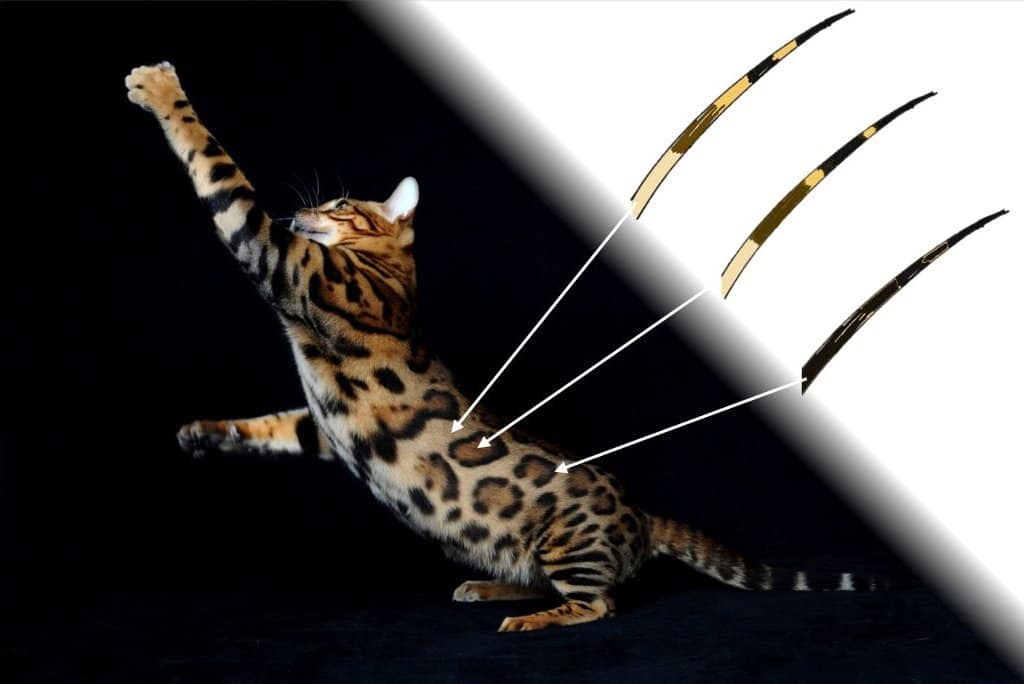Cat coat colors explained
Cat geneticsThe genetics behind the cat coat colors
Have you ever wondered how it is possible, that a cat’s coat can have so many different colors, styles and patterns? To answer this question, it is necessary to dive into the genetics of cats.
20 genes determine the coat color and pattern
As with all living beings, the body of a cat is made up of cells. In every nucleus of the body’s cell are chromosomes. Each chromosome consists of a very long, interwoven and coiled thread. This is the DNA. The structure of DNA looks like an very long spiral staircase (the famous double helix). The steps of this staircase contain the building blocks for hereditary traits. A number of steps in succession is called a gene. Each gene describes the code of a trait, which (co)determines how the cat looks, how the body works or how the cat is. Cats have 38 chromosomes (by comparison, humans have 46). Chromosomes always come in pairs, so a cat has 19 pairs.
Of the chromosome pairs, half are provided by the mother and half by the father. The bottom line is that every hereditary trait is present twice. So the same is true for genes, which also exist in pairs and consist of two parts or variants. One coming from the father and one from the mother. Such a variant of a gene is called an “allele. In other words, one hereditary trait is composed of two alleles. For readability, we use the words “gene” (instead of allele) and “gene pair” (instead of 1 gene consisting of 2 alleles) for the rest of the article.
Dominant and recessive traits
The genes of a gene pair can be the same or different from each other. This is due to spontaneous mutations. Some genes of a gene pair are dominant, while others are recessive. An example is eye color in humans. The gene for brown eyes is dominant over the gene for blue eyes. So someone with a gene pair consisting of one gene for brown eyes and one gene for blue eyes will have brown eyes, because brown is dominant. The same goes for cats. If a cat inherits two equal genes then we call it a homozygote. If a cat inherits a dominant and recessive gene we call it heterozygous. In this case, the trait of a dominant gene will be expressed. Such a cat is then called a “carrier” of the recessive gene. A recessive trait is visible only if both parents pass on the recessive gene. Dominant genes are indicated by a capital letter, while recessive genes are indicated by a lowercase letter.
There are 5 categories: color, modifiers, tabby, white and hair style
A cat possesses around 20,000 genes, and about 20 genes are responsible for coat color and pattern. Furthermore, a cat possesses “only” two types of color pigments: the red/orange/yellow pigment (phaemelanin) and the black/brown pigment (melanin). In addition, all cats are basically tabby (striped). The extent to which colors and patterns are visible (or masked or suppressed) depends on a number of specific genes. These genes are denoted by a letter. There are 5 categories:
- The genes that determine colors: Agouti, O, C and E-genes.
- Color modifying genes: B, D and I-genes + Wideband effect.
- The genes for stripes and spots: Tabby genes.
- The genes for white coat, spots or socks: W-genes.
- The genes for the style of hair: hair length, curls, hairless, bengal fuzzy and glitter.
The interaction of all these genes collectively determines the final color, shape and pattern of the coat. These genes are described in detail below. At the end of the article is a table listing all the genes, some examples with the complete genetic description of cats, the links to the references used for this page and material for further reading.
Genes that determine color: A, O, C and E-genes
A-genes: Agouti or non-Agouti
The Agouti gene (denoted by capital A) is the natural wild gene responsible for the tabby (striped) pattern in cats. The Agouti gene is dominant and determines how each individual hair is provided with color. The shape of the stripes or spots on the coat is further determined by the Tabby genes, described further on. As each individual hair grows, the Agouti gene is responsible for the switching between the red-yellow and black-brown pigment resulting in bands of different colors. The tip of a hair is always dark, while the base is light. A mutation of this gene causes it to stop switching to the red/yellow pigment, resulting in a hair with solid or uniform color. We call this non-agouti or “hypermelanistic” and describe it with the lowercase letter (a). Perhaps the best-known melanistic wild cat is the black panther. Non-agouti (a) suppresses or masks the agouti (A) pattern, but the pattern is sometimes still visible with the right light, as seen in the photo of a black panther below. We call this ghost-striping or ghost-markings.
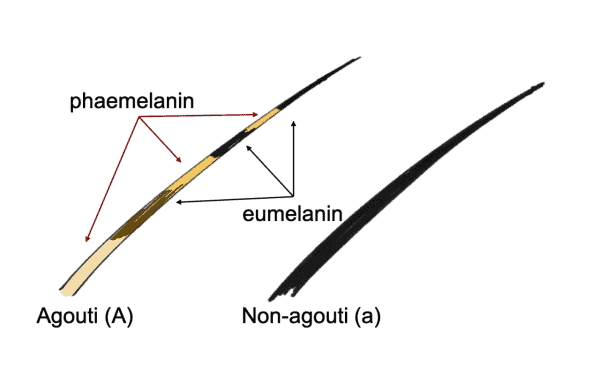
Illustration of an agouti hair, where the hair is composed of bands of red-yellow pigment (phaemelanin) and black-brown pigment (eumelanin). In a non-agouti hair, there is no change to phaemelanin and the hair becomes uniform in color.
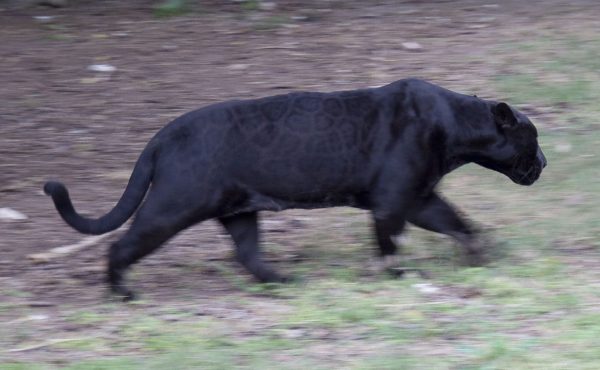
Photo of a black panther. The agouti pattern with spots is suppressed by the non-agouti (melanistic) gene, but is still visible in the right light. This is called ghost-striping or ghost markings.
Non-agouti (a) is recessive and thus only visible if a cat inherits the non-agouti gene (a) from both parents. So an A/A or A/a cat (referred to as A/-) is tabby. An a/a cat is uniform of color. Thus, the common black cat is a carrier of two recessive a-genes. So, to what extent a kitten will become tabby or uniform of color depends on what the parents are carrying:
- A/A x A/A ⇒ 100% A/A = 100% tabby kittens.
- A/A x A/a ⇒ 50% A/A + 50% A/a = 100% tabby kittens, but half are melanistic “carriers.
- A/a x A/a ⇒ 25% A/A + 50% A/a + 25% a/a = 75% tabby (of which 2/3 are melanistic carriers) and 25% melanistic kittens.
- A/a x a/a ⇒ 50% A/a + 50% a/a = 50% tabby (and all melanistic carrier) and 50% melanistic kittens.
- a/a x a/a ⇒ 100% a/a = 100% melanistic kittens.
Bengals may possess a special variant of agouti derived from the Asian Leopard Cat (the ALC): Apb – Agouti prionailurus bengalensis. Apb is not completely dominant over (a). An Apb/a bengal is called a charcoal, with the characteristic darker markings than an A/- bengal, the dark dorsal stripe and the mask on the face. In addition, Apb/A and in particular Apb/Apb bengals often exhibit a drawing with already greater contrast than A/A bengals. Especially for silver bengals, this is a desirable trait for breeders.
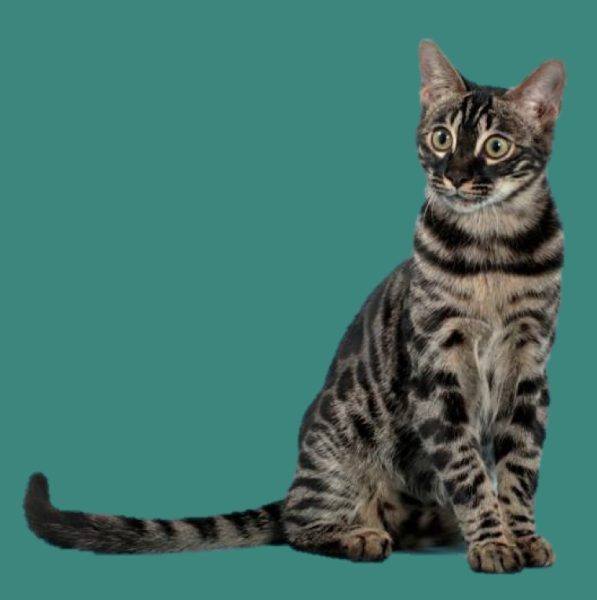
Charcoal brown bengal
O-genes: Orange
The O-gene provides the orange-red color of cats and is special for two reasons. First, it occurs only in cats and not in other animals. Second, it is present on the X chromosome and thus the orange color is linked to the sex of the cat. The O-gene blocks the production of the black-brown pigment (eumalanin), leaving only orange-red pigment (phaemalanin). Orange (O) is dominant over the recessive non-orange (o).
Females are XX and have two X chromosomes and therefore can have a coat that is completely orange-red (O/O), spotted orange-black (O/o) – known as a tortie or tortoiseshell cat – or have a coat with hairs that have both pigments (o/o). In the latter case, the A-gene determines whether the cat is uniform (black-brown) or tabby in color. Males are XY and have only one X chromosome. Therefore, they can have a completely orange-red coat (Y/O) or a coat with hairs that have both pigments (Y/o), with the A-gene again determining tabby or solid. Tortoiseshell cats are orange-black spotted which requires two O-chromosomes and are therefore always females (with the exception of XXY males which have an extra chromosome).
Another special trait of the O-gene is, that the non-agouti gene (a) is suppressed by the O-gene (in other words the O-gene is epistatic for non-agouti). Therefore, orange-red cats are never uniform in color and are also always tabby. And for red-black tortoiseshell cats, although the black part may be uniform in color, the orange-red part retains its stripes.
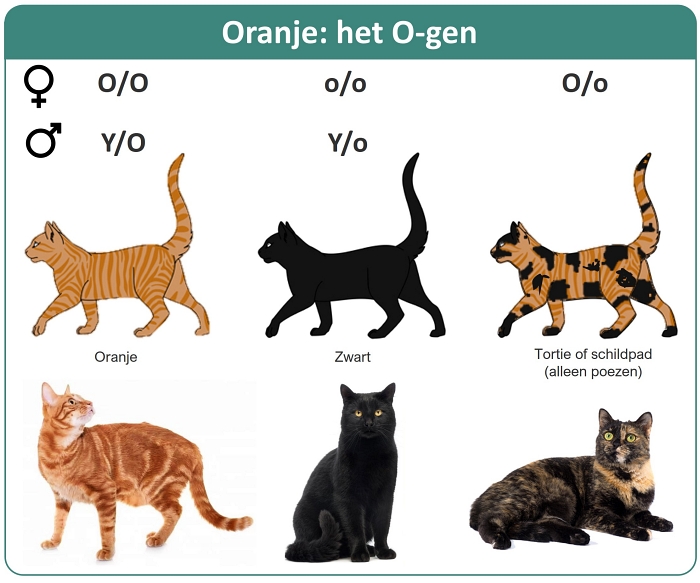
C-genes: Color, Colorpoint and Albino
The C-gene controls the pigment generation. The C-gene is completely dominant, and when it is active, the cat can have a full color. A recessive mutation (c) can cause the gene to be completely inactive and no pigment is produced, resulting in a white albino cat (with red or blue eyes). There are also a number of additional recessive mutations that cause colorpoints. The cs (siamese) and cb (burmese) mutations provide temperature-sensitive pigment production. As a result, more pigment can be formed on the cooler parts of the body such as back, feet, face and tip of the tail. So in the siamese (which is cs/cs), this produces the typical pattern of a light color on the body with a dark muzzle, ears, feet and tail. Because these parts are at the end(points) of the body, these cats are called colorpoint. Colorpoint bengals are called “snow. Cb is less temperature sensitive than cs, which is why cb cats have darker bodies. The dominance of this gene is as follows: C > cb = cs > c. The designation of the colors is as follows:
- C/- = full color.
- cb/cb = burmese colorpoint. In bengal: snow seal sepia.
- cb/cs = tonkinese or mink colorpoint. In bengal: snow seal mink.
- cs/cs or cs/c = siamese colorpoint. In bengal: snow seal lynx.
- c/c = albino.
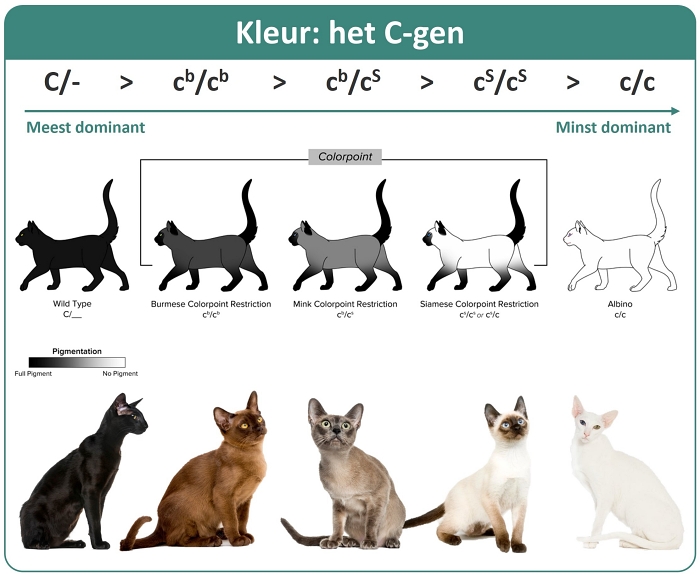
E-genes: Extension or Amber color
The E-gene affects the production of black-brown pigment. In cats, this was first found in Norwegian forest cats. A recessive mutation of this gene (e) causes a gradual replacement of the black pigment with a yellow pigment as the cat grows up, manifesting as an amber coat. Several years ago, a similar mutation of the same gene was found for burmese cats. For burmese, we call the color “russet” (denoted by “er”). The E-gene is less important for cats and more important for dogs and horses, where (e/e) is responsible for the beautiful golden color of the Golden Retriever, the rich red color of the Irish Setter and the noble sorrel/chestnut color seen in horses.
In bengals, this can also occur. A “rufous” (rust colored) bengal has a warm, red background, while in a “sorrel” the black fades to reddish-brown. This phenomenon was more common in bengal from earlier generations than it is today. Rufousing is different from tarnish: in rufous, red pigment is produced instead of black-brown pigment. In tarnish, the red pigment is not completely suppressed by the silver inhibitor (see below). In brown bengals, rufousing can be a welcome variation, while in silver and melanistic bengals it is undesirable.
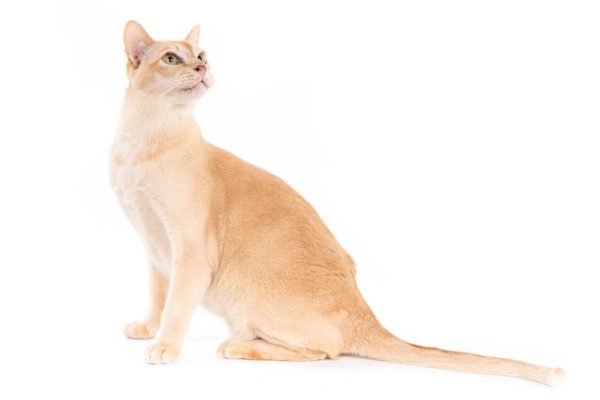
Russet colored burmese
Genes that adjust color: B, D and I-genes + Wideband effect
B-GENES: BLACK (B), CHOCOLATE (b) AND CINNAMON (b1)
The B-gene affects the intensity of the black pigment. Brown is recessive trait that changes the black (B) to a chocolate (b) or cinnamon (b1) color. If you would look at an individual hair under a microscope, the pigment in black cats is round shaped, while in chocolate cats the pigment is oval-shaped and in cinnamon it has the shape of a rice grain, making it appear lighter. B is dominant over b, which in turn is dominant over b1. Black cats are thus B/B, B/b or B/b1 (B/- for short). Chocolate cats are b/b or b/b1 and cinnamon cats are b1/b1.
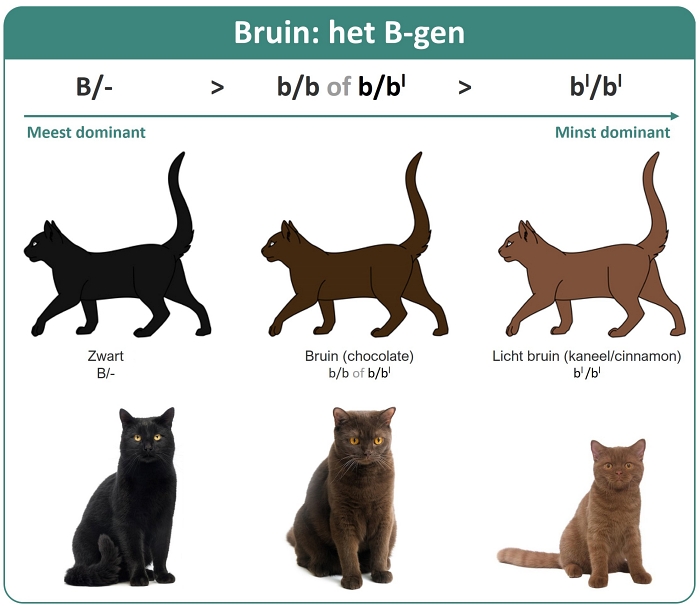
D-GENES: DILUTION (d) AND DILUTION MODIFIER (Dm)
The dilution gene is a recessive trait that makes the normal color lighter or paler. Cats carrying D/D or D/d show full color. For cats carrying d/d, the colors are modified. Black becomes blue, chocolate becomes lilac, cinnamon becomes fawn and orange becomes cream.
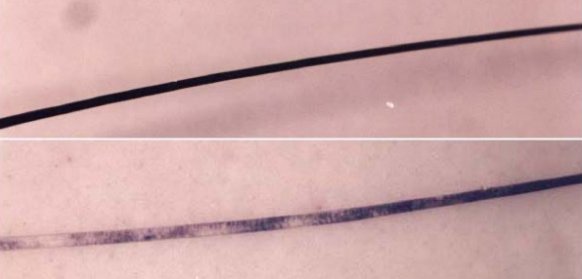
Black and blue hair
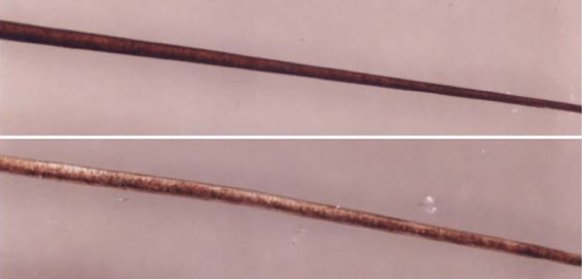
Chocolate and lilac hair
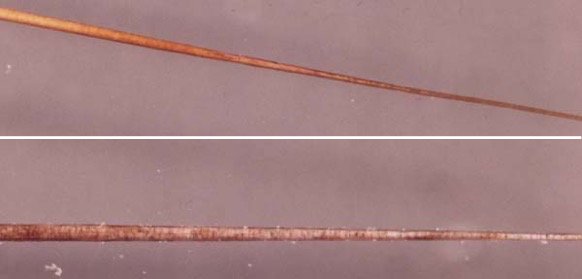
Cinnamon and fawn hair
If you would look at an individual hair under a microscope, the pigment in d/d cats is not spread uniformly throughout the hair, but grouped into clusters with little to no pigment between the clusters. As a result, part of the hair is transparent, leading to the lighter color. With a dilution-modifier (Dm) carrier, diluted colors become warmer. Dm only affects d/d cats and not D/D or D/d. Blue, lilac and fawn cats with Dm are given a caramel color tone. Cream takes on an apricot hue.
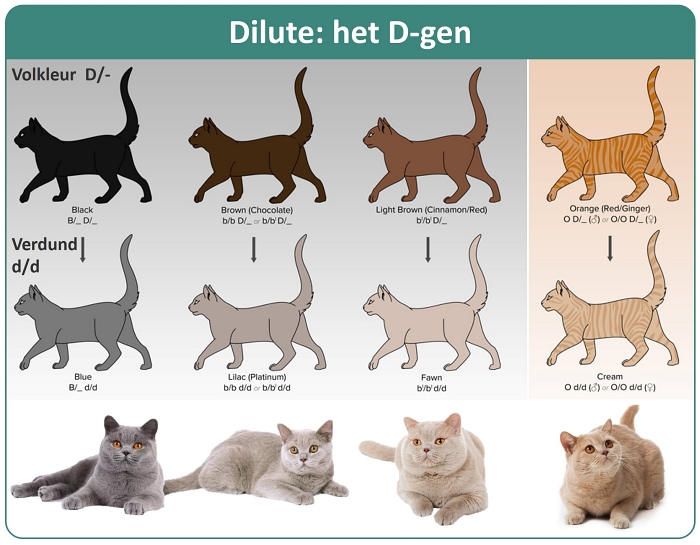
I-genes: silver and smoke + Wideband effect: shaded, chinchilla
The I-gene (I for Inhibitor) inhibits the production of pigments in the hair. It has much more effect on the red-yellow pigment (phaemelanin) than on the black-brown pigment (eumalanin). In solid-colored (a/a) cats (non-agouti), pigmentation is inhibited for the lower part of the hair. This leads this to a smoke color. Smoke colored cats look dark, but have a light undercoat that can be seen if you would push the hairs apart. For tabby cats (A/-), such as the bengal, the I-gene creates a silver undercoat. Non-silver is denoted by (i). In some cases, the production of pigment in the base of the coat cannot be completely suppressed, so the coat may still contain light shades of brown. This is called tarnish and is often undesired by breeders.
In tabby cats, there are also a set of other genes (polygenes) that can adjust the length of the bands in agouti hairs, in other words, how quickly there is a switch between black and silver. Effectively, this determines to what extent the top half of the hair still gets pigment. This is called the Wideband effect (Wb = wideband active, wb = wideband inactive). Wideband has no effect on solid-colored cats (non-agouti a/a).
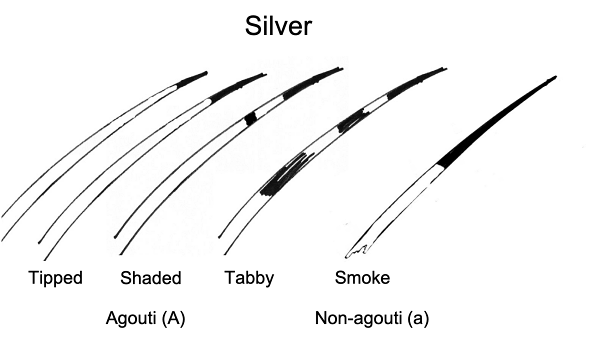
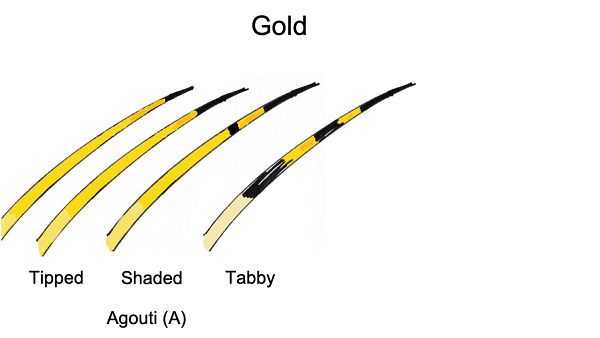
Illustration of the pattern of a tipped, shaded, tabby hair (silver or gold) and smoke hair (silver only).
Regular tabbies are wb and the Wideband is not active. With shaded, less than the (top) half of a hair still has pigment. With chinchilla (also called tipped or shell), only the tip of the hair has pigment left. So wideband can have different gradations and is therefore described by Wb (for shaded) to Wb++ (for strong chinchilla). Wideband also affects black or brown tabby cats, i.e. the non-silver cats. This creates the “gold” color. So a gold shaded or tipped cat is not silver (i/i), but is Wideband (Wb to Wb++). Golden smoke does not exist because smoke is caused by the silver I-gene and not by the Wideband effect.
The silver gene (I) is dominant over non-silver (i). An (I/i) silver male can have both silver and brown kittens as offspring. An (I/I) silver cat produces only silver kittens. To date, the silver gene cannot be tested and therefore it can only be determined from litters produced whether a cat is I/i (if there is ever a brown kitten in a litter) or most probably I/I (if there are always only silver kittens). Below are examples of the silver and gold chinchilla, shaded, tabby and smoke effect for a british shorthair.
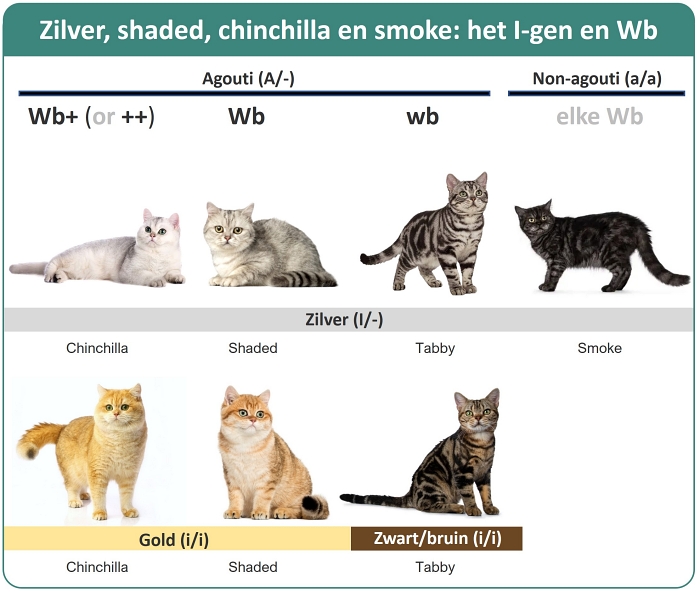
The genes for stripes and spots: T-genes
Tabby genes: Mackerel, Classic, Spotted and Ticked
Wild cats such as tigers, leopards or jaguars are famous for their beautiful spots, rosettes or stripes. A coat with these patterns is called “tabby”. Tabby cats are agouti (A/-). There are 4 types of tabbies:
- Mackerel: a striped cat, named after the striped pattern of the fish.
- Classic: a cat with “swirls” of stripes, also called marbled or blotched.
- Spotted: a cat with spots.
- Ticked: a cat with no visible pattern of stripes or spots, as in the abyssinian.
If you were to look at the individual hairs in a tabby cat, the hairs at the darker striped or spotted part have more black-brown pigment. While the hairs at the light parts have less black-brown pigment. So the degree of Agouti varies across the coat.
Tabby
The word “tabby” refers to a striped (wavy) silk taffeta. The name is a corruption of ‘attābī, short for Al-‘Attabīya, a quarter in the city of Baghdad where silk was produced in the 16th century. The name for the garment was adopted in medieval Latin as attabi, and then in French as tabis.
In the Netherlands, we know the term ‘cyperse’ (Cypriot) for striped cats. It is not clear where this came from. Possibly from the trade of such rugs by Venetian merchants through Cyprus.
Illustration of the coat structure in a black tabby bengal, where the degree of agouti varies across the coat. In the light spots, the hairs have a greater amount (wider bands) of red-yellow pigment (phaemelanin), while in the black parts, the hair is made up almost entirely of the black pigment (eumelanin).
There are several genes responsible for Tabby patterns:
Mackerel (Mc) and classic (mc): the mackerel gene provides the striped pattern, while cats with a classic pattern have a marbled coat. Mackerel (Mc) is dominant over recessive classic (mc).
Ticked (Ta): This is a largely dominant gene, which removes the pattern from a mackerel/classic tabby, leaving the cat with a uniform agouti coat. A Ta/ta no longer has stripes on the body, but still has them on the legs, face, neck and tail. A Ta/Ta cat has only visible stripes on its face. A ta/ta cat is not ticked and thus does have a visible tabby pattern.
Spotted (Sp): this denotes the collection of genes (polygenes) that cause, that the stripes of a mackerel are broken up and thus provides spots (as for example of a cheetah). In an Sp/Sp cat, there are complete spots. In a Sp/sp, the stripes are only partially broken up and the spots are still partially connecting. For sp/sp, the stripes are not broken up. Spotted (Sp) has no effect on cats with a classic pattern (mc/mc).

Toyger with a mackerel pattern
Mc/- and sp/sp
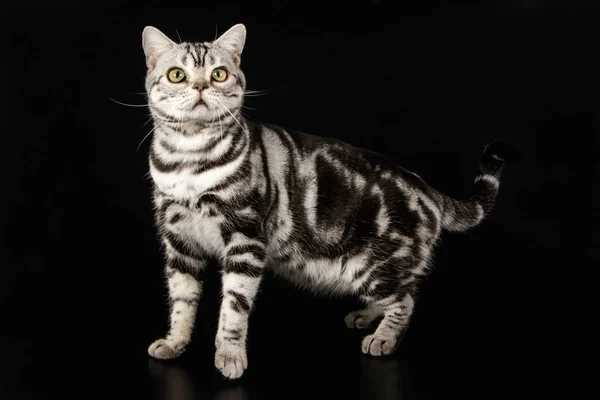
American shorthair with a classic pattern
mc/mc (any Sp)
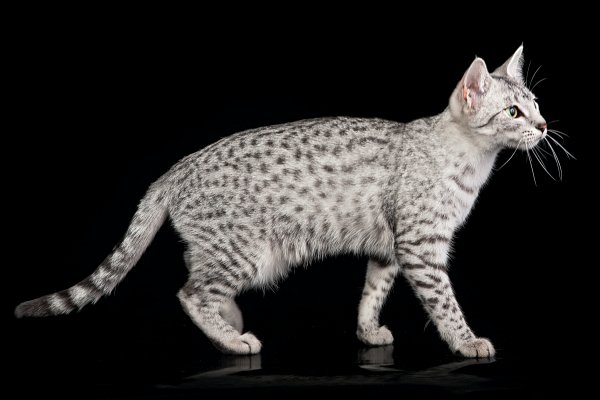
Egyptian Mau with a spotted pattern
Mc/- and Sp/Sp
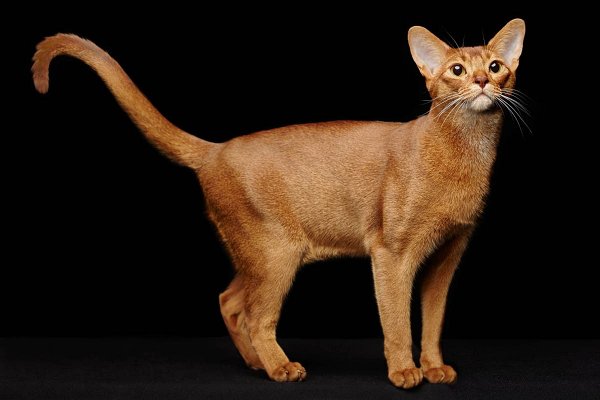
Abyssinian with a ticked pattern
Ta/Ta (any Mc and Sp)
One might wonder, how it is actually possible for a cat to develop a stripe or spot pattern at all. How does a coat “know” that a band or group of dark hairs should be placed in one place and light hairs in a different place? This question remained unanswered for a very long time and only very recently, in 2021, an article appeared in Nature, revealing more about the mechanism responsible for spot formation. It appears that as early as skin formation in the embryonic stage, it is determined where the spots or stripes will be formed. More on this can be read here, here and here.
Bengals can have not only spots, but (donut) rosettes, where the spots in the middle are dark brown with a black ring around them. Or bengals can have a marble pattern, where the classic swirls are broken up and multiple colors can be seen in the marble pattern. An intermediate form is the clouded rozetted bengal, in which the rosettes are very large and lay against each other. How the rosettes are formed and which genes are responsible for them is not exactly known. However, for convenience, this trait is referred to as the Bengal modifier or Bengal markings (Bm), with the modifier for those providing rosettes and marble (Bm) being dominant over the basic mackerel/classic and spotted patterns (bm). Thus, a bengal with isolated rosettes is Mackerel (Mc/-), Spotted (Sp/Sp) and has the Bengal modifier (Bm/-). A bengal with clouded rosettes is Mackerel (Mc/-), has large rosettes that are almost joining (Sp/sp) and and has the Bengal modifier (Bm/-). A marble bengal has a classic pattern (mc/mc) and the Bengal modifier (Bm/-).
- Rosettes: Bm/-, Mc/-, Sp/Sp, ta/ta
- Clouded rosettes: Bm/-, Mc/-, Sp/sp, ta/ta
- Marble: Bm/-, mc/mc, any Sp, ta/ta
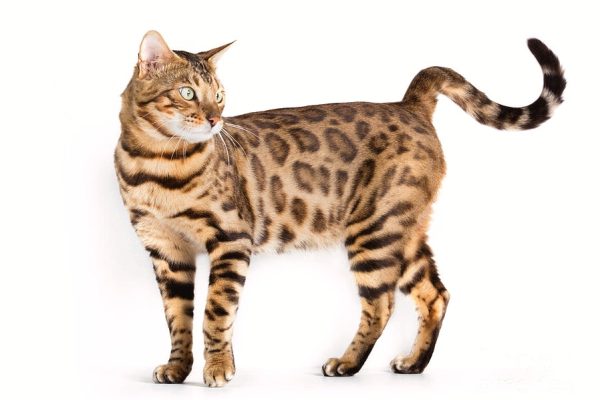
Bengal with rosettes
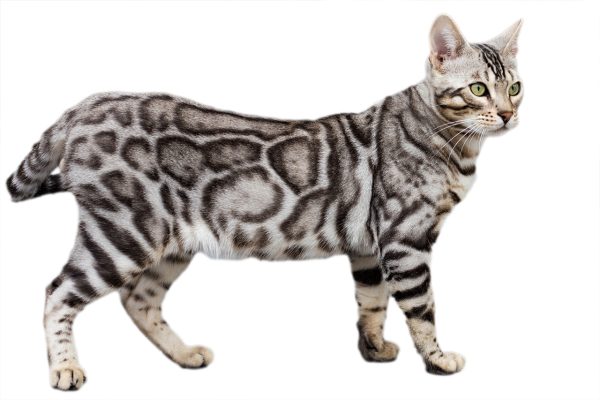
Silver bengal with clouded rosettes

Bengal with marble pattern
Genes for the white coat: W-genes
W-genes: White coat, spots And socks
A cat with a black and white fur is probably one of the most common colors of normal domestic cats. A white coat color, spots or gloves are caused by the fact that the cells that produce pigment (melanocytes) are not distributed to the skin layer during embryonic development, which prevents a hair from being pigmented during growth. This disorder is caused by a defect in the so-called KIT genes. For dominant white (W), there are no pigment-producing cells present in the skin at all, so the coat cannot acquire color. This gene also causes blue eyes and deafness. For white cat with 2 blue eyes, 60-80% are completely deaf. In white cats with 1 blue eye, 30-40% are deaf and in white cats with other eye color, 10-20% are deaf, with the remaining portion often having impaired hearing in varying degrees.
In cats with partially white coats or white spots (Ws), pigment cells spread (only) to part of the skin. In those parts the coat can have its normal color (black, red, tabby etc). The rest is white. Partly white cats do not suffer from deafness. Cats without white fur is denoted by (w). Ws/Ws cats tend to have more white than Ws/W cats. The degree of white on the coat can vary greatly. The Turkish Van only has color on the ears and tail and the rest of the cat is completely white. This is called a Van pattern. Cats with only a few spots are called “harlequin.” Bicolor cats have a greater amount of (irregular) white spots. The pattern of cats that have a black face and a large spot on their back is called “cap and saddle.” When a larger part is black we call it “mask and mantle” and cats that have only a white chest and feet appear to wear a black suit and are therefore called “tuxedo” cats.
Finally, there are cats with only white gloves (wg), which is caused by another mutation. For Birman cats, this has even become part of the breed standard and all Birmans are wg/wg. The white glove mutation wg is fully recessive. The order of dominance of white is: W > Ws > w > wg.
- W/-: all-white cat.
- Ws/Ws: cat with white spots or mostly white.
- Ws/w: same as Ws/Ws, but often less white.
- Ws/wg: cat with white spots and white gloves.
- w/w: normal or non-white cat (apart from albino).
- w/wg or wg/wg: white gloved or mitted cat.
Incidentally, the white gloves in Ragdolls come from another dominant gene (designated Sb, Sm or s2). The effect of this gene are white feet, chin and a white strip on the underside of the body to the tail.

The genes for hair length, curls, hairless, bengal fuzzy and glitter
L-genes: longhair or shorthair
L genes are responsible for coat length. Shorthair (L) is dominant over longhair (l). Therefore, long-haired cats carry two genes of the recessive variant and are l/l. A 2007 study found that hair length is caused by four mutations of the so-called fibroblast growth factor 5 (FGF5) gene. Mutation 1 and M2 are unique to Ragdolls and Norwegian forest cats respectively. M3 was found only in Maine Coones and Ragdolls. M4 was found in all long-haired cats.
Rex mutation for curly hair
Besides shorthair and longhair, there are also cats with curly hair, this is called the “rex” mutation. For cats several mutations are known, including r (in cornish rex), gr (in german rex), re (in devon rex), ro (in Oregon rex), se (in selkirk rex) and Lp (in LaPerm). Currently, only 4 rex cats are internationally recognized: Cornish Rex, devon Rex, LaPerm and Selkirk rex.
H-genes: hairless or bald cats
Finally, there are hairless cats, the most famous of which is the (Canadian) sphynx. For the sphynx, this is caused by the recessive hr (hairless) gene. Other hairless cats include the Peterbald and Russian Donskoy (Don-sphynx), where this is caused by the dominant Hp gene.
Fuzzy phase of bengals
When bengal kittens are about 3-4 weeks old, they develop a longer fluffy coat, which temporarily hides their pattern. This is called the “ugly fuzzy” phase and originates from the wild ancestor, the Asian tiger cat (ALC). For feral cats, the fuzzy is more common. The most clear example is of the cheetah cubs, where the entire back has a strip of long hair, see the photo below. The fuzzy phase increases the chances of survival for wild cats. The fuzzy fur is developed in the same period when the cubs are slowly leaving the nest for exploring. A fuzzy coat provides extra camouflage among the tall grass and it also offers extra protection against bad weather. In addition, a cheetah kitten in the fuzzy phase resembles a honey badger somewhat. A honey badger is one of the most fearless animals and notorious for its uncommon ferocity and fighting spirit, causing hyenas, leopards and even lions to prefer to leave them alone. After about 4-5 months, the bengal coat clears up again, revealing its beautiful pattern. The final color and pattern of the coat is achieved at 12 months of age.
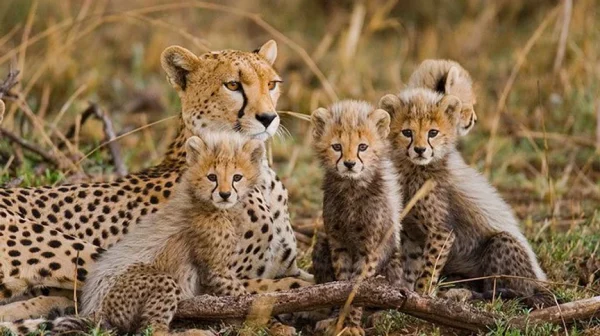
Cheetah mother with her cubs, that are clearly in the fuzzy phase.
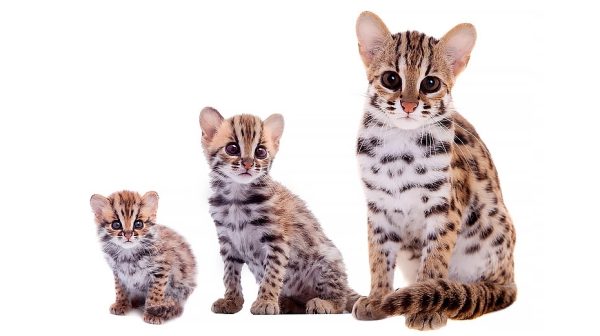
Progression of the fuzzy phase for the Asian leopard cat.
Glitter at bengal
The last feature we will describe in this article is bengal glitter. Where bengal kittens go through an “ugly fuzzy” phase, adult bengals more than make up for this with a beautiful coat that can look like someone sprinkled stardust over it. This is caused by the glitter gene. Unfortunately, not all bengals possess this trait. The color of the glitter depends on the color of bengal. Charcoal bengals have silver glitter, brown bengals have gold glitter and silver bengals have crystal glitter. Melanistic bengals cannot have glitter. Studies show that there are two types of glitter: satin and mica. The recessive satin glitter gene (gn) causes air pockets in the hair, refracting light and giving the coat a soft, silky appearance. There is also the mica effect, in which there are highly reflective silica crystals in the tips of the hair. This is caused by the recessive mica gene (mi). Bengals with satin and mica are thus (gn/gn) and (mi/mi). The glitter effect comes from the Indian male used by Jean Mill in her breeding program: Milwood Tory of Delhi, the primal father of the bengals (see the article on the history of the bengals).
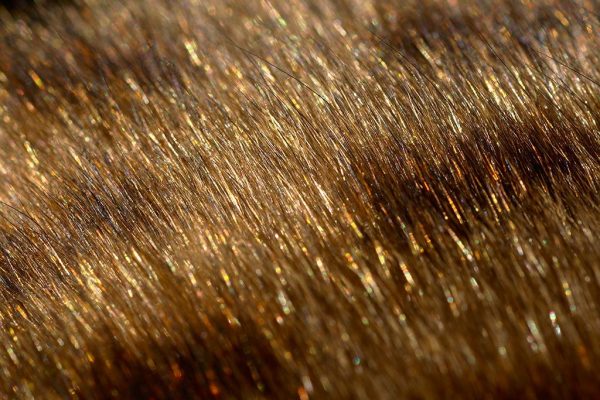
‘Mica’ glitter on a black tabby bengal
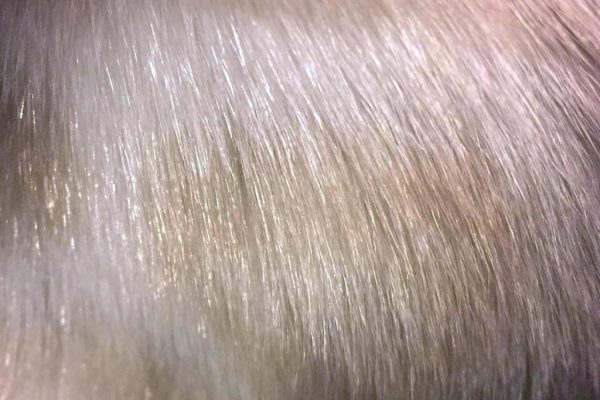
‘Satin’ glitter on a seal mink bengal
Overview of all genes in a table
All genes responsible for the cat coat colors and patterns are shown in the table below with a breakdown by dominant gene and recessive mutation.
| Gene | Dominant | Recessive |
|---|---|---|
| Agouti | A - agouti (wild type) Apb/a - charcoal | a - non-agouti (solid color) |
| Black/Brown | B - black/brown | b - chocolate bl - cinnamon |
| Color | C - solid color | cb - burmese colorpoint cs - siamese colorpoint c - albino |
| Dilution | D - undiluted | d - diluted: black/brown → blue chocolate → lilac cinnamon → fawn orange → cream |
| Dilution modifier | Dm - changed d/d colors: Blue/lilac/cinnamon → caramel Cream → abricot | dm - no effect |
| Amber (Extension) | E - produced black pigent | e - black pigment → red er - burmese russet |
| Glitter | gn - bengal satin mi - bengal mica | |
| Hairless | Hp - Don sphynx and Peterbald | hr - Canadian sphinx |
| Inhibitor (Silver) | I - silver | i - not silver |
| Long hair | L - shorthairl | - long hair |
| Orange | O - orange/red | o - wild type |
| Rex | Lp - Laperm | r - cornix rex re - devon rex gr - german rex ro - oregon rex se - selkik rex |
| Spotted Tabby | Sp - dominant modifier: Mc → spotted | sp - not spotted |
| Tabby | Mc - Mackerel | mc - classic/blotched |
| Tabby - Bengal modifier | Bm - rosettes or marble | bm - basic mackerel, classic or spotted |
| Ticked Tabby | Ta - uniform agouti coat. Dominant over Mc and Sp | ta - spotted or striped coat. |
| White | W - white. Masks all colors | Ws - white spots w - not white (colored) wg - white gloves/mitted |
| Wideband | Wb - wideband active: non-agouti → smoke agouti → shaded/chinchilla (i/i + Wb = gold) | wb - wideband inactive |
Five examples of the complete genetic description of the cat
All the genes described above collectively determine the colors and pattern of the cat coat. Below are five examples of different cats and which genetic description belongs to each cat.
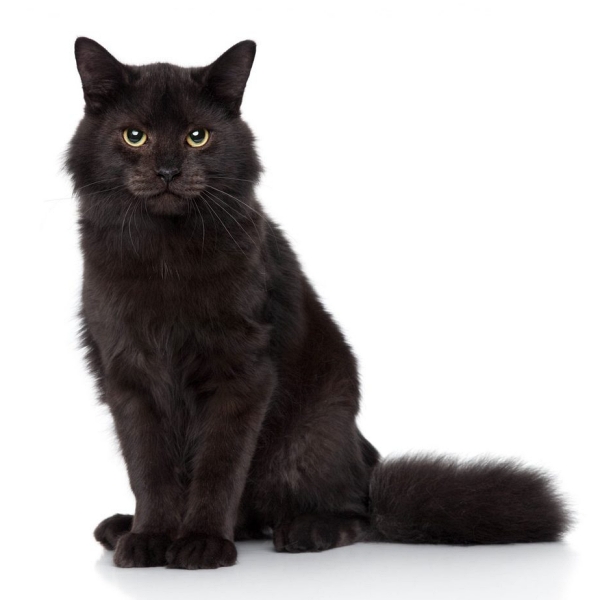
Black Siberian longhair
a/a, B/-, C/-, D/-, i/i+wb,
L/L, w/w, o/o
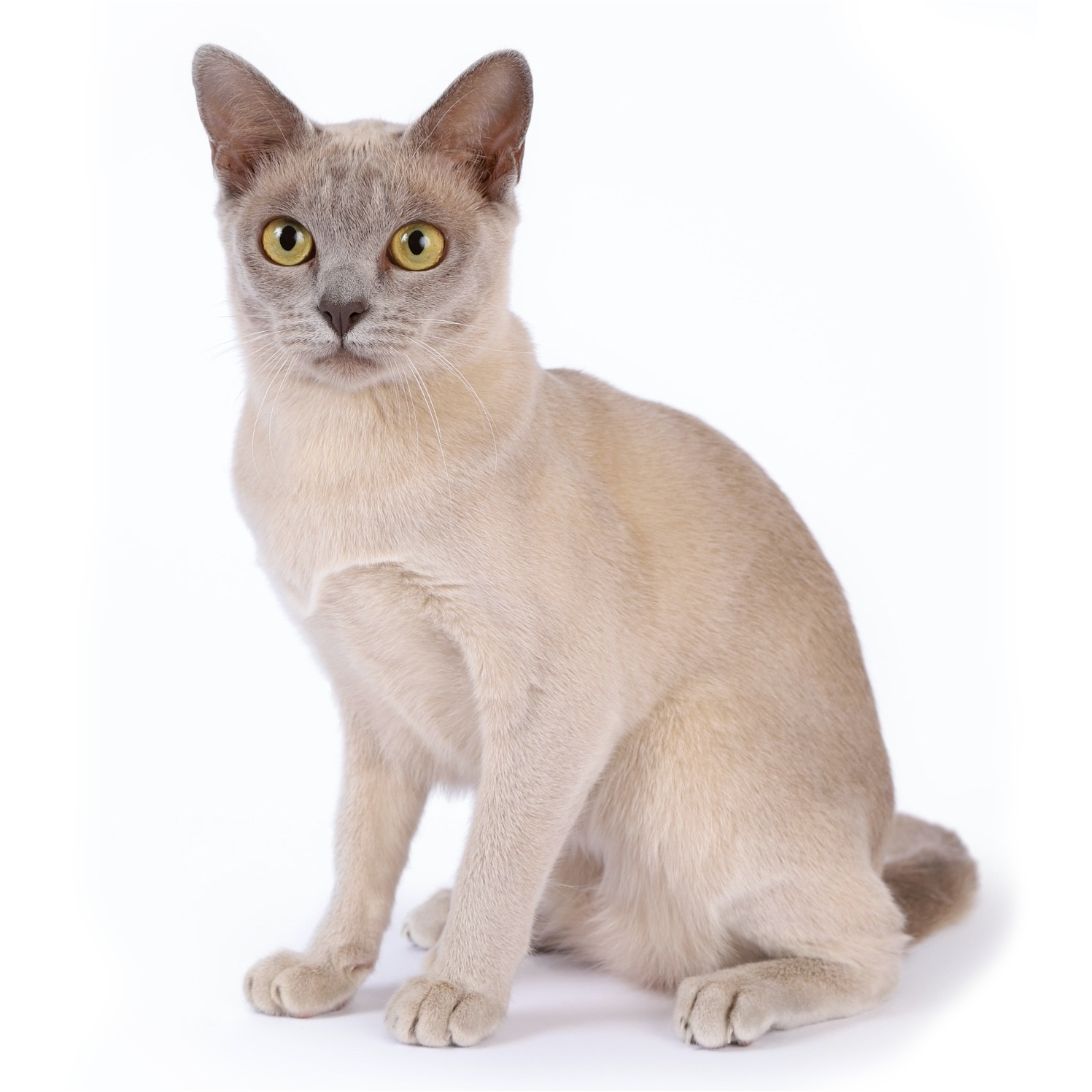
Lilac Burmese
a/a, b/b, cb/cb, d/d, i/i+wb,
L/L, w/w, o/o

Blue point bicolor Ragdoll
a/a, B/-, cs/cs, d/d, dm/dm, i/i+wb, l/l, Ws/Ws, o/o
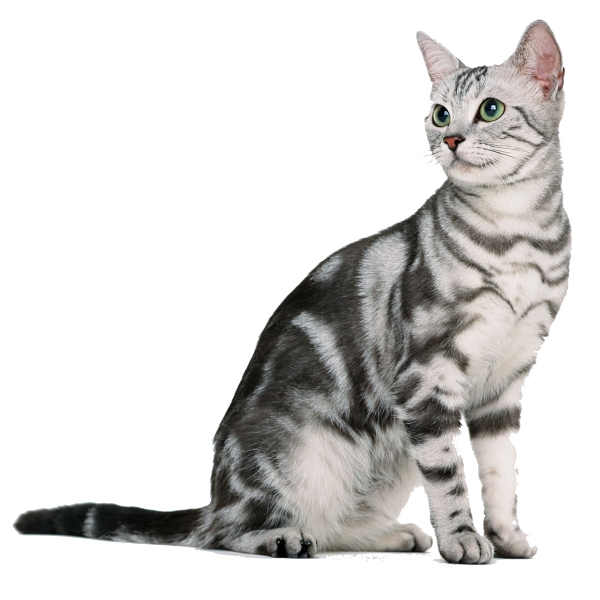
Silver tabby British shorthair
A/-, B/-, C/-, D/-, I/- wb, L/L,
mc/mc, sp/sp, w/w, o/o

Red tabby spotted bicolor
A/-, B/-, C/-, D/-, i/i+wb, L/L, Ws/Ws, mc/mc, Sp/Sp, O/-
Testing for coat color can be done at UC Davis
Wondering what color genes your cat has? Testing a cat coat color can be done at several laboratories around the world. One of the best known is the veterinary genetics laboratory at the University of California at Davis in the US. Bengals can be tested for Agouti here (A), charcoal (Apb), Brown (B), Colorpoint constraints (C), Dilute (D) and Amber (E). For our cattery, we also use this lab and the results of the color tests can also be found in the documents for our queens and studs.
References and further reading
https://www.gccfcats.org/wp-content/uploads/2021/09/BasicCatgenetics.January2022.pdf
http://messybeast.com/colours-conformation-index.htm
https://basepaws.com/blogs/news/cat-coat-genetics
https://sparrows-garden.com/genetics.html
https://www.thehappycatsite.com/cat-colors/
https://thelittlecarnivore.com/en/blog/cat-coat-tabby-patterns-genetics
https://www.hdw-inc.com/geneticsofcolors.htm
https://ecoevocommunity.nature.com/posts/how-the-serval-gets-its-spots
https://med.stanford.edu/news/all-news/2021/09/cat-fur-color-patterns.html
https://www.nationalgeographic.nl/we-weten-nu-hoe-cyperse-katten-hun-strepen-krijgen
https://www.nationalgeographic.com/animals/article/how-tabby-cats-get-their-stripes
https://www.nature.com/articles/s41467-021-25348-2
http://ib.berkeley.edu/courses/ib162/Week3a.htm
https://pubmed.ncbi.nlm.nih.gov/27671997/
https://www.ncbi.nlm.nih.gov/pmc/articles/PMC4199695/
https://pubmed.ncbi.nlm.nih.gov/17767004/
https://academic.oup.com/g3journal/article/4/10/1881/6025589
https://slideplayer.com/slide/5162101/



